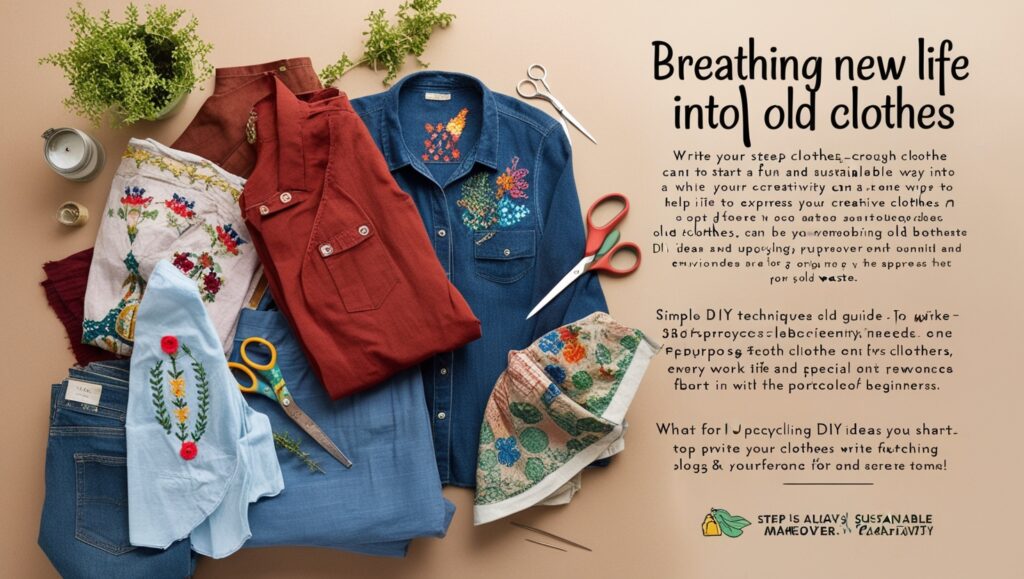Revamp Old Clothes A Creative Guide to Sustainable Fashion
In a world increasingly conscious of waste and sustainability, revamping old clothes is more than just a fun DIY project—it’s a way to reduce your environmental impact, save money, and showcase your creativity. Whether you have a wardrobe filled with outdated outfits or you’re just looking to personalize your style, upcycling old clothes can breathe new life into forgotten pieces. Revamp Old Clothes A Creative Guide to Sustainable Fashion Here’s a comprehensive guide to help you transform your clothing into unique, stylish, and wearable art.
Why Revamping Clothes is Worth It
- Eco-Friendly: Fast fashion contributes significantly to environmental degradation. By reusing and revamping clothes, you reduce waste and limit your carbon footprint.
- Budget-Friendly: Instead of buying new clothes, you can save money by updating your existing wardrobe.
- Personalized Style: Upcycled clothing allows you to express your unique style. No one else will have the same piece!
- Creative Outlet: Revamping clothes is an enjoyable and therapeutic hobby that allows you to experiment with designs, fabrics, and techniques.
Steps to Revamp Your Old Clothes
1. Assess Your Wardrobe
Start by going through your closet and identifying items you no longer wear. Look for clothes that:
- Don’t fit but could be resized.
- Are outdated but have potential for modernization.
- Have minor damage, such as stains or tears, that can be creatively hidden or repaired.
2. Gather Your Tools
To begin your revamping journey, you’ll need:
- Sewing kit or sewing machine.
- Fabric scissors.
- Fabric glue.
- Needles and thread in various colors.
- Iron-on patches, buttons, beads, and embroidery supplies.
- Paint or fabric dye for customization.
3. Explore Revamp Ideas
a. Resize and Tailor:
- Turn oversized shirts into chic crop tops or fitted blouses.
- Shorten maxi dresses into midi or mini dresses.
- Transform wide-legged pants into stylish shorts or skinny jeans.
b. Add Decorative Elements:
- Use embroidery to add intricate designs to plain clothes.
- Sew on lace trims, sequins, or beads to elevate basic garments.
- Apply iron-on patches to cover stains or add a fun touch.
c. Repurpose Fabric:
- Create headbands, scrunchies, or scarves from leftover fabric.
- Use parts of one garment to enhance another, like adding ruffles to a skirt or a pocket to a shirt.
d. Dye and Paint:
- Revive faded clothes with fabric dye. Consider trendy tie-dye or ombre effects.
- Use fabric paint to create patterns, quotes, or artistic designs.
e. Distress and Reimagine:
- Create distressed jeans by cutting and fraying edges.
- Transform old sweaters into cozy mittens or leg warmers.
4. Experiment with Layering and Styling
Sometimes, the key to revamping isn’t in altering the garment but in how you wear it. Revamp Old Clothes A Creative Guide to Sustainable FashionTry layering pieces, mixing patterns, or accessorizing in new ways to give your outfits a fresh feel.
Creative Projects for Inspiration
- Turn a T-Shirt Into a Tote Bag: Cut the sleeves off an old t-shirt and sew the bottom closed for a quick and reusable bag.
- Sweater to Cardigan Transformation: Cut down the center of a pullover sweater and add a button or zipper to make a stylish cardigan.
- Scarf Belt: Use a colorful scarf as a unique belt to add flair to dresses or jeans.
Tips for Successful Upcycling
- Start Simple: If you’re new to DIY, start with minor alterations like hemming or adding accessories.
- Watch Tutorials: Platforms like YouTube offer countless tutorials for creative clothing hacks.
- Be Patient: Upcycling takes time and practice, so don’t rush the process.
Final Thoughts
Revamping old clothes is not just about fashion—it’s about sustainability, creativity, and self-expression. It empowers you to step away from the fast-fashion cycle and contribute to a more eco-friendly world, all while refreshing your wardrobe with one-of-a-kind pieces. Revamp Old Clothes A Creative Guide to Sustainable Fashion So, grab those forgotten items from your closet, unleash your inner designer, and enjoy the process of transforming the old into the extraordinary.
Revamping your clothes isn’t just a trend—it’s a lifestyle choice that’s both stylish and sustainable. Revamp Old Clothes A Creative Guide to Sustainable Fashion Why not start today? Your closet (and the planet) will thank you!

